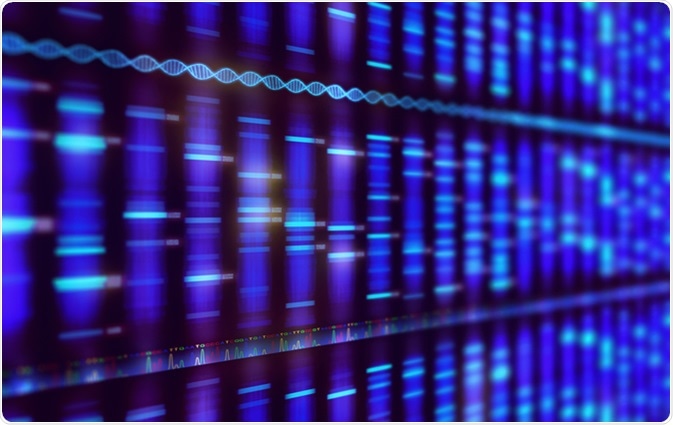By Shelley Farrar, MSc, BSc
Sanger sequencing involves sequencing DNA by first copying single-stranded DNA by adding nucleotides to the chain. Each DNA fragment is terminated by the incorporation of a fluorescently labeled deoxynucleotide.

DNA sequencing. Image Credit: ktsdesign / Shutterstock
A sequence is formed as the fragments are separated by capillary array electrophoresis and then put into order by the base-specific fluorescent label. Overlapping sequences are arranged from the output to reflect the actual genomic sequence.
The progression towards automated DNA sequencing started with system platforms that consisted of thin slab gels, then the use of capillaries, and now a microfabricated chip. Sanger sequencing originally required costly reagents at high volumes in order to fulfill the required volume minimal limit; however, microfluidic Sanger sequencing technologies allow sample volumes to be scaled down.
Further advances have been introduced; the multiple laboratory techniques used for Sanger sequencing have been integrated onto a chip, with this type of application often referred to as ‘lab-on-a-chip’ technology. Samples are interfaced to a microfluidic system where volumes are at the nanoliter scale.
The Structure of Microfabricated Chips
DNA sequencing chips have a four-layer construction and are usually no more than a few tens of square centimeters. The most common material used is borofloat glass in the form of 100 millimeter glass wafers. The first two thermally bonded glass wafers hold the capillary electrophoresis channels.
The third layer sometimes consists of a polydimethylsiloxane (PDMS) membrane, which along with the bottom glass wafer layer, form the channel interconnections. The material used has the advantage of good thermal conductivity and a well documented surface chemistry. The chips can be fabricated with both deep and narrow channels at a low cost. Such high geometric aspect ratios have the advantage of lengthening sequence reads and increasing detection sensitivity.
Comparison of Microfluidic Devices to Previous DNA Sequencing Methods
The use of microfluidic platforms increases throughput in comparison to capillary array electrophoresis because of the improved sample injection and separation times. Capillary array electrophoresis inserts the sample via electrokinetic injection into the capillary. The method has only a short injection time meaning small amounts of sample are introduced.
A bias towards shorter DNA fragments can also occur with this method. Because the sample is introduced via a channel network in microfluidic devices, they have a reduced susceptibility to these injection problems. Early microfabricated chips displayed a ‘T’ shaped injector design which has been replaced with a ‘cross-T’ or ‘offset double-T’ injector design; this provided superior sample control.
Capillary electrophoresis on-chip provides separation times that are ten times faster than traditional capillary electrophoresis and one hundred times faster than slab gels.
Advantages of Microfluidic Sanger Sequencing Technologies
The main advantage of microfluidic Sanger sequencing technologies is that they provide the integration of many laboratory protocols, including sample handling, reaction, separation and detection. When samples are transported between instruments there is a risk of sample dilution or loss.
Contamination becomes a further issue during transport when the sample contains a low copy number or is from a single-cell. In such cases the contaminant can overwhelm the sample. The fully integrated automatic system in microfluidic devices means these problems are avoided and there is an improved performance.
How does Sanger Sequencing Work? – Seq It Out #1
The speed of analysis has also increased because of shorter diffusion distances and fast heating. Both contact and non-contact heating methods have been found to be suitable for microfluidic devices. Traditional Sanger sequencing cleanup requires either expensive reagents or a time consuming clean using ethanol.
In comparison, automated sampling uses less reagent for cleanup and is therefore more cost effective. Whilst glass has a general high material cost, the price of fabrication can be lowered when manufactured in high quantities. Furthermore, the increasing use of cheap plastics and elastomers means microfluidic Sanger sequencing technologies are a cost effective method of DNA sequencing.
Sources:
- Kan, C. et al. 2009. DNA sequencing and genotyping in miniaturized electrophoresis systems, Electrophoresis, 25, pp. 3564-3588. https://www.ncbi.nlm.nih.gov/pubmed/15565709
- Metzker, M.L. 2005. Emerging technologies in DNA sequencing, Genome Research, 15, pp.1767- 1776. http://genome.cshlp.org/content/15/12/1767.full
- Paegel, B.M. et al. 2003. Microfluidic devices for DNA sequencing: sample preparation and electrophoretic analysis. Current Opinion in Biotechnology, 14, pp. 42-50. http://www.sciencedirect.com/science/article/pii/S0958166902000046
- Bruijns, B. et al. 2016. Microfluidic devices for forensic DNA analysis, Biosensors, 6, e41. http://www.mdpi.com/2079-6374/6/3/41
- Liu, P. & Mathies, R.A. 2009. Integrated microfluidic systems for high-performance genetic analysis, Trends in Biotechnology, 10, pp. 572-581. https://www.ncbi.nlm.nih.gov/pubmed/19709772
Further Reading